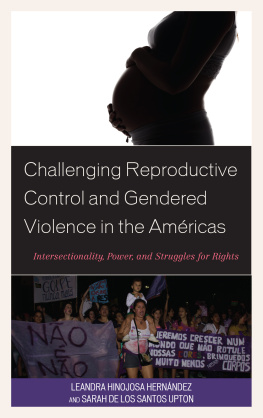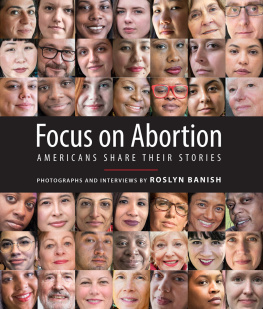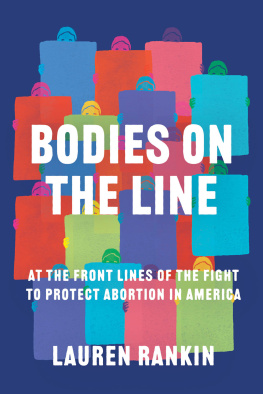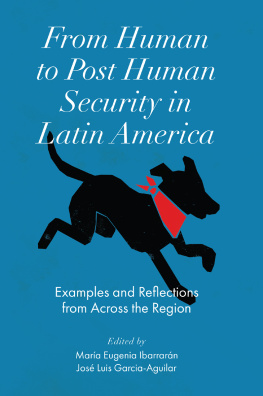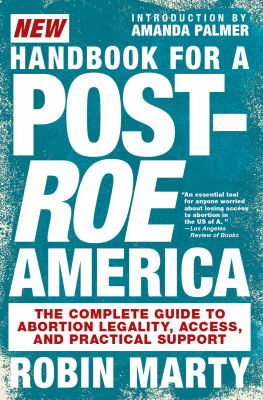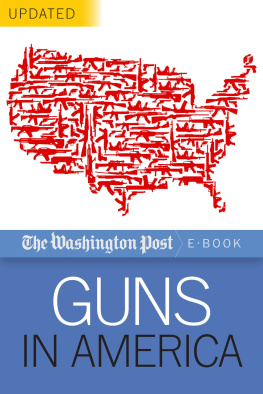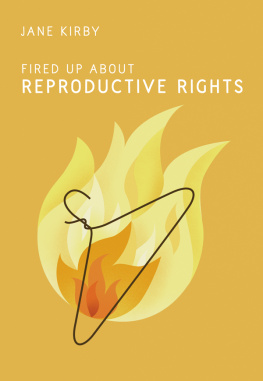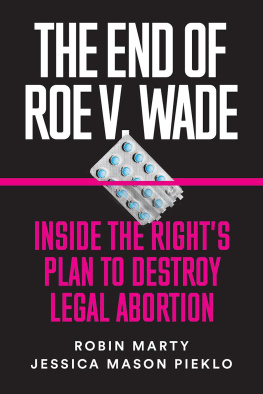All rights reserved. No part of this book may be reproduced in any form or by any means, electronic or mechanical, including photocopying, writing or recording, or through any other system for the storage or retrieval of information without the written permission of the publisher.
Names: Marty, Robin, author.
Title: Handbook for a post-Roe America / Robin Marty.
Description: New York : Seven Stories Press, [2019]
Identifiers: LCCN 2018050872| ISBN 9781609809492 (paperback) | ISBN 9781609809508 (ebook)
Subjects: LCSH: Reproductive rights--United States--History. | Abortion--United States--History. | Abortion--Law and legislation--United States--History. | Pro life movement--United States--History. | Pro-choice movement--United States--History. | Social change--United States.
Printed in the USA.
Prologue
Why This Book?
For a large section of the US population, the 2016 presidential election was a turning point. It shook complacent mainstream Americans out of their stupor and alerted them to the danger that marginalized communities already knew: that as long as the financial and political power of the country remained concentrated in the hands of the rich, the white, the male, and the conservative, those outside that power structure would see their own rights dismantled at a rapid pace.
The realization brought millions to the streets on January 21, 2017, as the Womens March spurred women and their allies in cities throughout the US to protest President Donald Trumps inauguration. In commercial airports, people protested the administrations Muslim travel ban, while white allies joined the community of Standing Rock in their ongoing effort to stop the Dakota Pipeline project. Back in DC the March on Washington protested the lack of gun restrictions after a year full of mass shootings, and all along the border protestors gathered as asylum seekers and their children were ripped from each others arms and deported simply for the crime of seeking safety in the United States.
It took the reality of a puppet-figure Republican president, a religious right-dominated Congress, and now the most conservative Supreme Court in modern history to finally push progressive Americans of privilege to take action. For cisgender, straight, white, middle- and upper-class women especially, the idea that legal abortion (and even birth control) could actually disappear, and that the restrictions could be vast enough to affect more than just those of color, those in low-population areas and the South, and the rural and urban poor has become a harsh reality. The announcement that Supreme Court justice Anthony Kennedy was retiring and that yet another Trump nomination would tip the court to the right for decades to come was a wake-up call that has thrown those not regularly engaged in reproductive-rights activism into action.
But what, exactly, should we be doing right now?
While this moment may feel like a crisis point, the truth is that for many communities this fight has been going on for decades, even centuries. Modern gynecology came about through experimentation on black slaves. Todays contraceptives were initially testedoften coercively and without any informed consenton women of color. Our medical history is highlighted by periods of sterilization of those who were disabled, or too poor, or the wrong color, or who had what we considered too many children. The decades prior to Roe v. Wade were filled with young girls hidden away to give birth, only to have their babies stolen and given to worthier families.
While Roe and the cases that preceded it made birth control and abortion legal, they did nothing to curtail the coercive power our government wields over the bodies of those who can give birth. Roe limited abortion only to those who could afford it, while at the same time limiting the types of governmental assistance available to those who wanted to give birth and had larger families but didnt have the financial means. The same government that forbids abortion coverage in Medicaid insurance also allows states to put caps on how many children a mother can receive welfare benefits for. The same states closing abortion clinics and making it hard for the uninsured to access affordable birth control also periodically propose financial incentives for those who are poor to undergo sterilization procedures.
This isnt a crisis the Trump administration caused. This is only a crisis that Trump has brought to the main stage, one that he has finally forced us all to acknowledge and motivated us all to fighteven those who until now thought abortion either a settled issue or one that didnt affect them directly.
Now, the question is how to organize, and how to do it without replicating efforts, without undermining the work that has gone on for generations, and without putting others in danger. This book is written primarily for those who are looking at ways to prepare for the worst-case scenarios in a post-Roe Americaan America where pregnant people may need to travel across state lines, or obtain illegal abortion-inducing medications, or keep their abortions secret from partners, family, and the authorities. It is meant to provide an action plan that will allow you to do the type of activism that you are best suited forwhether it is providing financial support, offering yourself as someone who can protest or work outside the legal system because of the privilege that comes from your wealth, able-bodiedness, race, gender, or geographic location, or working within the political system to undo the oppressive laws that have restricted peoples ability to control their own reproductive futures. And it is meant to provide a personal blueprint for dealing with an unplanned pregnancy when abortion may be difficultif not impossibleto access.
These tactics arent meant for everyone. They are meant for those who have the privilege to be able to put their time, skills, money, and even personal freedom into making abortion accessible for everyone. Now that we all recognize the threat and are ready to act, we canand mustfinally shoulder this burden together.
Where We Are Now and
How We Got Here
How Did We Get Here?
On January 22, 1973, the United States Supreme Court ruled in a 72 decision known as Roe v. Wade that a pregnant person has the constitutional right to an abortion under that persons right to privacy. The ruling struck down all state abortion bans as unconstitutional, ending what was a growing patchwork of abortion legality that changed from state to state, ranging from legal in all circumstances to no abortion whatsoever.
The victory didnt last long. While the framework of Roe required that each state must make abortion legal until the point of fetal viability (then assumed to be at around twenty-eight weeks gestation, or by the beginning of the third trimester), and after that if the pregnancy poses a threat to the pregnant persons health, state and federal legislators immediately jumped in to see how quickly they could limit that decision with restrictions to the procedure itself.



